Menu
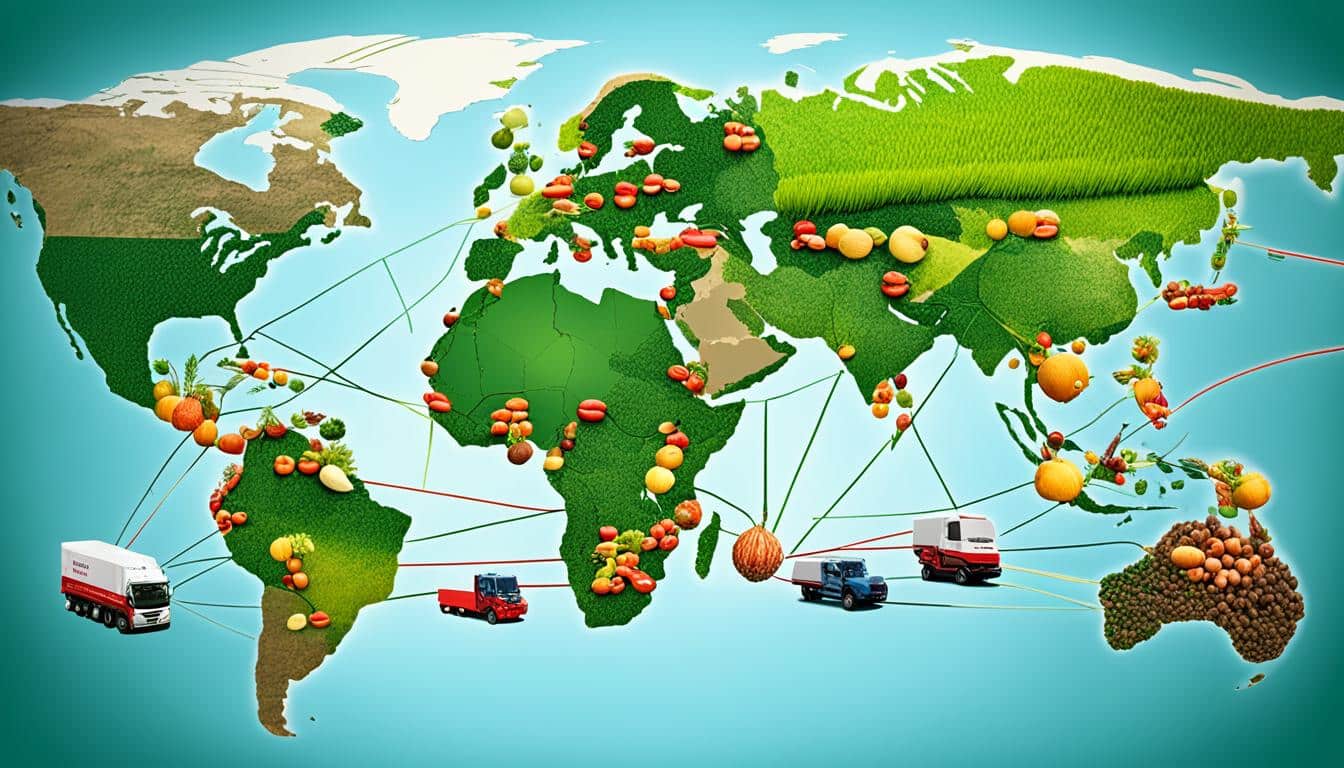
The European Union (EU) trades more food than any other part of the world. This shows how the EU shapes the global food trade. But, being a key player brings tough challenges. Global food markets can change fast because of the weather, politics, and the economy. This makes it hard for everyone involved, like farmers and buyers, to plan ahead.
The EU keeps a close eye on these market changes because it matters so much in trading food. It uses a special kind of math called agro-economic modelling to help see into the future. This modelling gives predictions that are the basis for making plans in the long term. So, the EU knows what might happen and can make smart choices.
The global agricultural market is complex. It’s affected by international trade talks, economic theories, and new technologies. The European Union (EU) is key in trading agricultural goods globally. It affects both export and import markets. This shows how the EU is deeply connected to the world’s agricultural trades, impacting many people.
Global agricultural markets face problems with prices changing often. This can lead to economic problems and even political issues. High crop prices worldwide can mess up the food supply chain. This affects both those who produce food and those who buy it. The EU’s yearly looks at the future of agriculture are important. They give us clues about what may happen in the next ten years. This knowledge is vital for making policies.
Global trade talks also directly affect the EU and its farm goods. The deals made in these talks set the path for future trading and market conditions. More valuable food types, like organic food, are becoming popular from the EU. This means the EU needs to work even harder to ensure these foods are of high quality.
Between 2002 and 2008, the number of future and option trades globally grew five times. This shows how important these tools have become in lessening the risk of changing prices in agriculture. It’s clear that we need thorough ways of looking at the food supply chain. This helps keep the market safe and steady.
Products with special labels need careful monitoring. The idea of a bioeconomy is becoming more popular. It’s about using natural resources in a way that takes care of the environment. The EU has set up a bioeconomy observatory to keep an eye on this growing market. It shows how the global market for farm products is changing.
To end, it’s crucial for everyone in farming to grasp the world of crop prices and food chains. The EU’s part in this field is huge. This shows why it’s important to stay flexible and study the market well to deal with the global agricultural market smoothly.
Agricultural trade has shaped societies and economies for ages. The change from local food-making to global trade networks has hugely impacted agriculture trade trends. This changes the global agricultural markets dynamics too.
Globalisation in the agricultural sector cut costs for trading across borders. This has brought growth and reduced poverty, especially in Asia. Also, new technology has made it cheaper to trade farm goods. This has further helped the economy and cut down on poverty.
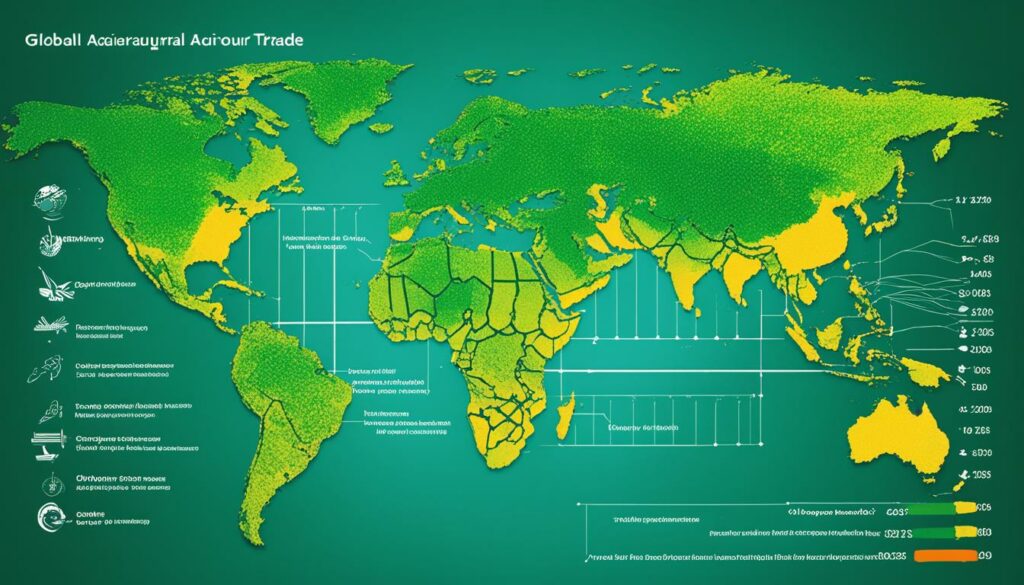
Since the 1980s, big changes in agricultural and trade rules have made a big difference. These changes have cut the bad effects of policies that change prices by over 50%. They show how global agricultural markets are changing.
More money and factories have made the agricultural sector grow slower, especially in busy areas. Now, you can see big differences in how much people invest in agriculture in different places. This varies according to GDP, jobs, land, water, and how much money is spent on each worker.
The way the world eats has changed a lot, moving towards more animal and plant foods. This matches the bigger growth in farming compared to other jobs worldwide.
| Region | Importance of Agriculture in GDP | Employment | Arable Land | Fresh Water | Capital per Worker |
|---|---|---|---|---|---|
| Asia | 20% | 25% | 15% | 10% | 5% |
| Europe | 15% | 10% | 17% | 5% | 10% |
How much natural resources and workers a country has shapes its strength in farming. Using these things in a smart way can lead to strong development. The amount of money each worker gets in farming also affects how well a country does.
Global agricultural markets see price changes due to many reasons. These include economic shifts, weather events, and political upsets. Knowing these helps traders make plans to deal with uncertain prices. This can keep crop costs stable worldwide.
Actions like betting on the future and trading options can shake up the market. Between 2002 and 2008, more people trading futures caused big price changes. High oil prices also play a part. They make moving goods and farming more expensive, changing crop prices a lot.
Weather is a big player in the crop market. Bad seasons can lower how much we grow. As an example, Malaysia had less rice in 2019 than in 2018. This was due to poor weather. The same goes for palm oil and rubber. Climate changes can make these crops more or less available. This shifts their prices globally.
Politics can suddenly change agricultural markets, too. Trade rules and world events can cause quick shifts in prices. For Malaysia, its palm oil and rubber might see these effects first. This is because they rely a lot on international markets.
Knowing all these reasons helps traders plan better. They can make strategies to deal with the challenges of international markets. This can lead to more stable prices for crops worldwide.
International trade talks are key in moulding the global agriculture markets. Whether they’re big deals between many countries or smaller ones, they shape how food moves around the world. Agreements like the WTO’s Uruguay Round and ongoing talks in the Doha Round really show their power. Knowing about these is a must for those who track market trends and plan ahead.

Trade talks can have big effects. Take the tariffs placed on agricultural products in 2018. These tariffs, targeting goods worth $30.4 billion in 2017, saw prices change by 2% to 140%. This shows just how important it is to predict what might happen economically.
The World Trade Organization (WTO) members set up tariff-rate quotas (TRQs). For over 20 years, the Economic Research Service (ERS) watched these quotas change. For instance, more than 900 Chinese businesses tried to get a wheat TRQ from 2015 to 2021. 171 of them asked every year for those seven years. These changes, due to big global agreements, show how market access worldwide shifts.
Not just global deals, but also regional and one-on-one deals affect markets. A report in 2016 looked at how opening Japan’s beef market affected the U.S. Bilateral talks have big effects. Also, differing standards on things like healthiness (NTMs) between the U.S. and EU make trade more complicated.
Learning the details of these trade talks means richer market reports and better strategic planning for food chains. As the world markets change, keeping a keen eye on the shifting opportunities is vital.
Keeping up with agricultural markets’ competitiveness means managing supply chain risks. This needs a mix of new technology and smart ways to handle stock.
New tech helps lower supply chain risks. For example, online selling gives us quick updates on what’s needed, cutting down on waste. Then, there’s tech that keeps products fresh for longer, making sure they reach customers in peak condition.
Managing stock well is key to meeting supply chain risks. By regularly topping up in-demand items, business can save money. This also makes them quick to adjust to changing market needs. Keeping just the right amount of stock around helps avoid both too much and too little, making the supply chain stronger.
| Company | Initiative | Result |
|---|---|---|
| Nestlé | Satellite-based monitoring | 97% palm oil supply traced to the mill level |
| Ghana Government | Cocoa tracking system | Trace cocoa pods back to farms |
| Digital Integration of Agricultural Supply Chains Alliance (DIASCA) | Best practices for traceability systems | Establishment of comprehensive traceability standards |
Supporting these tactics gives companies a better chance to handle uncertainty. With tools that forecast needs and strong trading plans, they can stay ready for changes. This makes the whole chain stronger against problems, keeping business running smoothly.
The EU Agricultural Market Outlook looks into the big picture. It examines things like the economy, future policies, and agriculture trends. Recent studies show that by 2030, EU agricultural production might drop by 12%. This could happen if the EU uses fewer resources. This highlights the big effect these changes could have on farming and international crop prices.
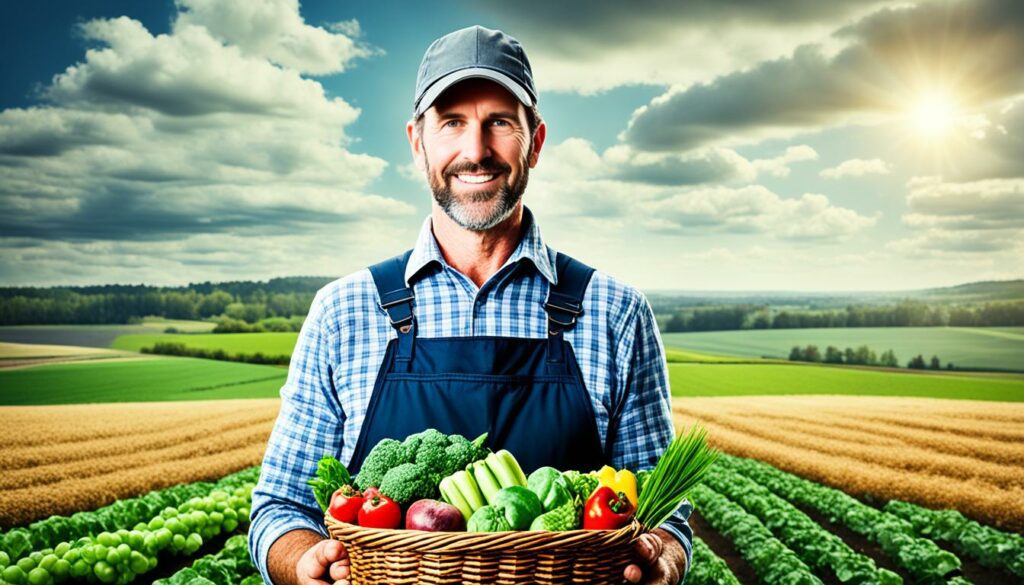
If the world follows the EU’s lead, global food and farming might see an 11% decrease. This proves how important it is to look at the market outlook reports for understanding the effects deeply.
In the U.S., some farm production could go up a little for some goods. But, any progress might be overshadowed by losses in other areas. This could mean growth of only 0.5%. It shows the need for a deep look at agriculture trade trends.
The JRC uses models to predict what might happen in different situations. It says EU food prices might rise by 17% because of fewer resources. This could also lead to a 9% rise in global food prices.
| Scenario | Food Price Increase | Reduction in Production |
|---|---|---|
| EU-only Adoption | 17% (EU) | 12% (EU) |
| Global Adoption | 89% (Worldwide) | 11% (Worldwide) |
| Impact on U.S. | 62% (U.S.) | 9% (U.S.) |
The impact of these reports is critical. They guide important policy decisions and help us get ready for the future. These reports also show the knock-on effect on GDP. They predict a $71 billion loss for the EU and a $94 billion drop worldwide if these policies happen.
Places with less money could be hit the hardest. If the EU acts alone, up to 22 million people more might struggle to get enough food. This number might go up to 185 million if the whole world cuts back on resources. This shows how essential it is to make smart, informed choices.
Market outlook reports help navigate the complex world of global agricultural markets. They offer valuable insights to farmers, policymakers, and others. These insights are based on careful analysis and assumptions.They let people make informed decisions in an ever-changing environment. For example, they give forecasts on supply and demand.
The EU uses a special method for looking ahead in the market. It looks at the next 10 years for market trends and agricultural incomes. This way, stakeholders can understand and prepare for future challenges.
A forecast for EU cereal shows it will reach 278.5 million tonnes in 2024/25. This is a 3% rise from the previous year. It helps with planning farm work and investments.
Next, reports show us some big trends. They say the EU’s milk supply will be stable in 2024 with better yields. However, EU wine consumption is falling.This fall is matched by a drop in production in Italy and Spain. Bad weather is the main reason for this.
Detailed forecasts add a lot to our knowledge of global agricultural markets. Let’s take a closer look at some forecasts:
| Category | 2023 | 2024 (forecast) |
|---|---|---|
| EU Per Capita Beef Consumption | 9.7 kg | 9.23 kg |
| EU Pigmeat Production | -6.6% | -0.4% |
| EU Poultry Consumption | +3% | +2% |
In the EU, consumer food prices have jumped in countries like Poland and Lithuania. They rose by 65% and 69% respectively. These jumps are key parts of the reports. They show how regional differences can affect the market.
In conclusion, market outlook reports are not just about numbers. They are essential for planning and preparing for the future of agriculture. They give us the insight we need to meet future challenges and seize opportunities.
Economic models are key for looking into the future of food supply chain. They help decision-makers prepare for a growing population. These tools assess agricultural trends, risks, and possible futures. This helps everyone understand and deal with the challenges in the food markets.
Income per person is expected to rise a lot by 2050. This will lead to more consumption of food crops. Thanks to growth in farm productivity, we predict a big rise in what we grow and eat. This increase is set to beat the rise in our population. It shows how powerful these models are in planning for the future.
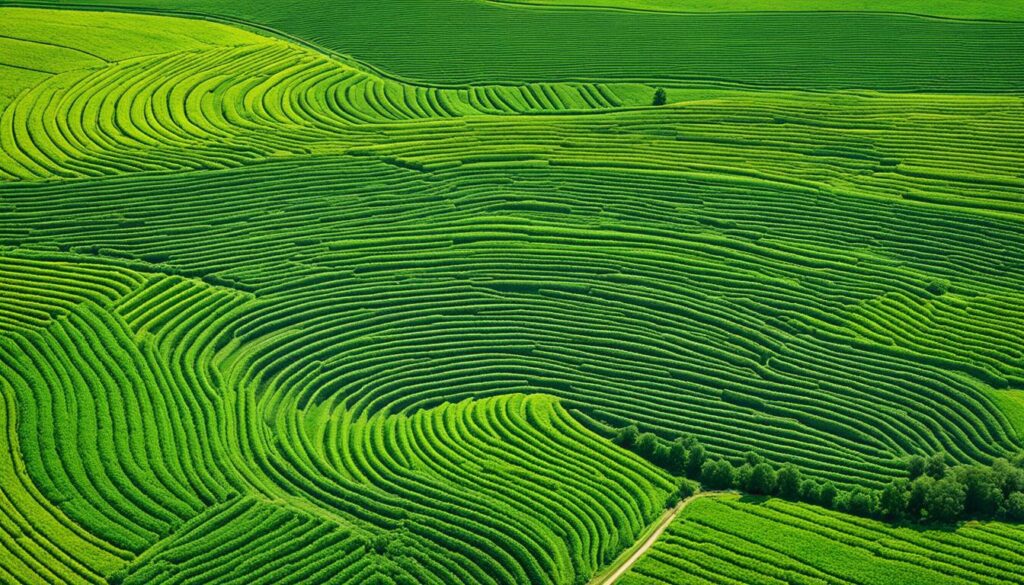
The JRC in Brussels is central to making these models better. By bringing together policymakers and experts, they improve forecasting accuracy. This global team effort enhances the use of new data analysis methods. They tackle the complex data from the farming world, making it usable for planning.
Models now look at various outcomes due to climate change. They consider different paths we might take and how much CO2 is in the air. Such studies show future prices could rise a lot for some foods, but fall for others. This information helps farmers make smart choices about what to grow or change about their farms.
| Crop | Price Increase by 2050 | Agricultural Productivity Scenario |
|---|---|---|
| Maize | 61.3%–80.9% | High |
| Soybeans | 36.7%–51.7% | Moderate |
| Wheat | 5.4%–11.1% | Low |
| Rice | -19.5%–-19.9% | Negative |
So, economic models are vital for making smart choices in trading. They pull data together for clearer decision-making. This helps make the food supply chain more stable against future challenges.
It’s vital to have strong trading strategies for *global agricultural markets*. These markets are always changing. Traders need to adjust to moves in *international crop prices*. They also use different tools to manage risks and make more money.
Futures and options are key in commodities trading. The volume of these trades increased five times between 2002 and 2008. This shows how important they are for risk management.
Futures let you set a price for a future sale or buy. Options give the right to buy or sell at a set price, but not the duty. This combo helps deal with ups and downs in *international crop prices*.
Trading directly in the spot market is also crucial. This involves buying and selling right now. It allows for quick reactions to changes in *global agricultural markets*. Traders can make fast deals for quick profits.
Reducing risk is central to the farming business. To shield against price drops, traders use various methods. These include forward contracts, insurance, and spreading investments between different assets. A solid risk strategy is critical for staying profitable when markets get tough.
Good *commodities trading strategies* offer more than just money. They help stabilise the market and improve future predictions. As *international crop prices* and market trends shift, educated traders can use past data and models to inform their choices.
Agribusiness market research faces many hurdles for industry growth. The gap between what small farmers can produce, and what they actually produce is a key issue in Sub-Saharan Africa. To close this gap, we must focus on trade trends and help farmers directly.
High costs in moving products can make things harder for small farmers in poor areas. They struggle to get everything they need. This leads to less productivity and more economic struggles. Also, bad storage can mean a lot of food goes to waste after harvest.

Women in farming often have more challenges than men, which can slow down the entire farming process. To make things better, we need to raise quality standards and give better market access. Training to fit their needs is also crucial for progress.
Agribusiness is a big source of greenhouse gases worldwide, up to 21%. It’s vital to look into how to make farming more ‘green’ to help our planet. Losing many bee colonies in the US in 2022 shows we have big issues to face.
With the chance of global competition, agribusiness must stay ahead. New technologies like bee vectoring and drones can keep them in the game. Big farming countries must do more to remain competitive.
The changing climate is a big problem for farming. Farmers need to change their ways quickly to keep up. As more people need food, the pressure on farming only grows.
Agribusiness has a rich history and many players, from families to big companies. People started farming over 11,000 years ago. Today, farming, raising animals, and managing forests all come with challenges unique to each sector.
| Challenge | Impact | Region Most Affected |
|---|---|---|
| Yield Gap | Reduced Productivity | Sub-Saharan Africa |
| High Transaction Costs | Inefficient Value Chains | Developing Countries |
| Limited Access to Inputs | Hindered Farmer Capability | Global |
| Quality Storage Issues | High Post-Harvest Losses | Global |
| Gendered Challenges | Limited Female Mobility | Global |
| Greenhouse Gas Emissions | Environmental Impact | Global |
| Bee Colony Deaths | Pollination Issues | United States |
| Climate Change | Increased Climate Volatility | Global |
To boost agribusiness, we must tackle these tough issues with solid research. We need to understand global farming trade and food chains. This way, we can help agribusiness grow in a way that’s good for everyone.
The bioeconomy is becoming more and more important worldwide, especially in places like the EU, Brazil, and Indonesia. It focuses on using renewable resources smartly to deal with growing needs and to cut down excess use.
There are three main views on the bioeconomy: biotech-focused, using a lot of materials, and farming-friendly. The first two have more say in decision-making. This shows there are two key ideas on what making the bioeconomy work well means: one that’s focused on using new tech and materials (biotech and biomass), and the other based on farming in ways that keep nature healthy (agro-ecology).
Although the bioeconomy offers a lot of hope, there are concerns about its effects on the environment and on people. Standards for making sure it’s done right and doesn’t cause harm have become very important. Many private groups and governments are working together to make these rules. However, how good these rules are can vary, and they might not always focus clearly on doing what’s best for nature.
The bioeconomy is set to be worth a huge amount, possibly $7.7 trillion by 2030. About 60 countries are already on board, and more are joining in. The FAO is very active in this area, with projects worth over $330 million. This makes up around 15% of its work.
How this works in real life is pretty amazing. For example, in Pakistan, they’re turning banana waste into clothing. In Côte d’Ivoire, they’re growing special flies to feed to animals. And in Yemen, farmers are making their own natural bug sprays from local plants and garlic.
| Region | Main Vision | FAO Projects |
|---|---|---|
| EU | Biotechnology-oriented | Developing bio-based products |
| Brazil | Biomass-oriented | Sustainable agriculture practices |
| Indonesia | Agro-ecological | Resource-efficient farming |
The bioeconomy can change how we think and work in the agricultural world. By understanding what’s needed and what’s available, everyone involved can use new, smart solutions while looking after the planet.
Higher value-added food supply chains are key to global food security. They provide products like organic, geographical indications, and Non-GM foods. People look for these because they meet specific standards and taste preferences.
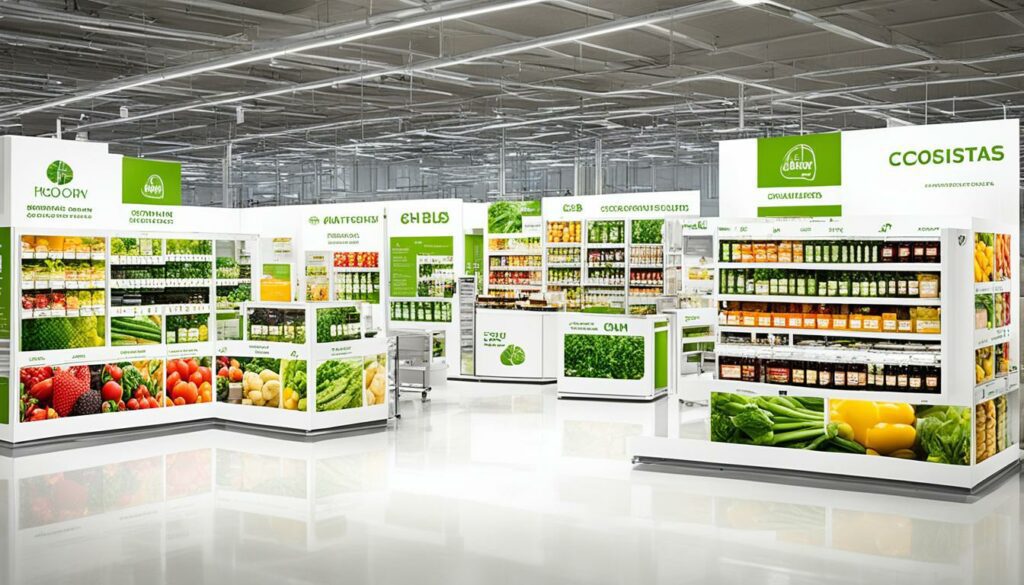
In homes, farmers get about 27% from what you spend on food. This % varies between 16-38% in different countries. However, we don’t focus enough on the value chain after the farm. There’s not enough data and ways to see how important it is. The U.S. Department of Agriculture’s study shows we need a better look at this Post-Farmgate food value chain.
Organic products are a big part of these special food chains. They aim to be good for the earth and people. But, getting certified as organic isn’t easy. Even so, it helps meet the big goal of global food security.
Geographical indications are also very important. They make food like Champagne and Roquefort cheese stand out. This makes them worth more, helping farmers earn better. It gives the food chain a strong economic base.
There’s a big need for Non-GM products. More and more people want food that is not genetically modified. So, the system for checking and making these is getting better. It shows why we need to manage these supply chains well, for better food quality and safety everywhere.
| Country Group | Farm Share of Consumer Expenditure (%) | Post-farmgate Value Addition (%) |
|---|---|---|
| Middle-Income Countries | 16-38 | Varied |
| High-Income Countries | 16-38 | Significant |
So, getting to know and improve higher value-added food supply chains is very important. Everything from organic products to geographical indications and Non-GM products helps. We need to work on making these supply chains better. This way, everyone from the producers to the consumers wins.
It’s essential to study food supply chains to make sure the world has enough to eat. A deep dive into these chains shows us how food gets from the farm to our plates. This helps us find and fix problems and manage risks better.
Food prices are going up faster than other things in almost half of the world’s countries. This puts a lot of stress on our food system globally. For example, maize and wheat are costing more, but rice has gotten cheaper in some places. Since January 2020, maize now costs 15% more, wheat is up by 3%, and rice has gone up by a lot, 47%.
New trends like people eating different things and buying from restaurants more are changing the market. This shift is making companies sell more fresh-cut and easy-to-eat foods. But, this means we need better ways to keep these foods fresh and move them around.
Prices going up so much in some countries is a real problem, especially for poor places. We need to look into the food chain deeply to make things better worldwide. And, making sure everyone can get enough food is really important. Sadly, over 282 million people are really struggling to eat enough, a number that has gone up by 24 million in just one year.
Bans on exporting food also have a big impact. By April 2024, 16 countries had stopped sending food out, and 8 had limits on how much they could send. These actions make the food chain less stable. So, we must work on creating better markets and ways to trade. This will help use our resources wisely, change economies for the better, and improve how we grow.
Connecting markets better can help bring food to places that need it most, like those facing the effects of climate change. Also, when food has a ‘green’ or ‘fair’ label, customers know it’s been made in a way that helps the planet and the people making it. This joins up our economic, social, and environmental aims. It’s key for a strong and fair food supply around the world.
| Country Income Level | Inflation Higher than 5% |
|---|---|
| Low-income Countries | 57.1% |
| Lower-middle-income Countries | 63.8% |
| Upper-middle-income Countries | 33% |
| High-income Countries | 12.7% |
Studying how food travels is key for everyone to have enough to eat. It helps us fix big and small problems in the food chain. This makes the food system stronger and fairer for all.
Being right about supply and demand forecasts is so important in farming. It allows the people involved to make smart choices and avoid making too much or too little. The latest numbers show us how these guesses affect the agriculture trade. Let’s dive into some major crop predictions.
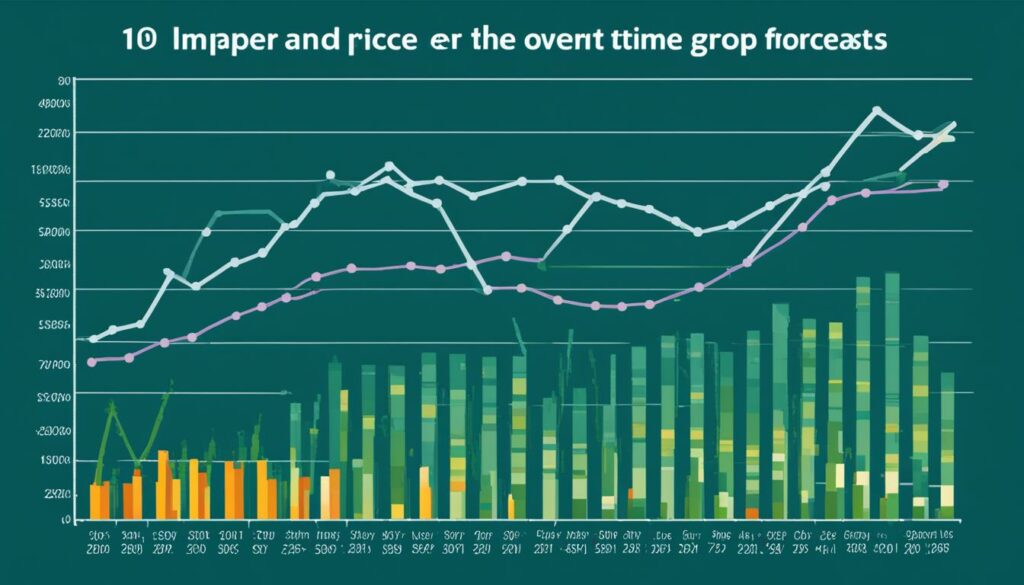
| Crop | 2023/24 Forecast (Million Tonnes) | Annual Change (%) |
|---|---|---|
| Global Rice Production | 529.2 | 0.7 |
| World Cereal Utilization | 2,829 | 1.4 |
| Global Coarse Grain Utilization | 1,510 | 1.6 |
| Global Wheat Utilization | 794 | 1.9 |
| World Cereal Stocks (End of 2024) | 890 | 2.1 |
| Global Coarse Grain Stocks | 372 | 5.6 |
| World Trade in Cereals | 487 | 1.6 |
| Brazil’s Maize Production | 111 | Slightly Above 5-Year Average |
| South Africa’s Maize Production | – | 10% Below 5-Year Average |
Agricultural trade is evolving thanks to new technology in storing, moving, and managing goods. These new ways make it easier to trade crops globally. For example, the World Agricultural Supply and Demand Estimates (WASDE) monthly report offers important info on primary crops. It helps a lot with planning and keeps the economy strong.
Prices for international crops can change based on the weather and politics. Take South Africa’s predicted lower maize crop due to bad weather. This shows why it’s vital to keep improving and have strong plans to keep the agriculture market stable.
The future of global agricultural markets depends on sustainable ways, tech changes, what people like, and good policies. These points show how the area is changing because of smart spending and wide research. The National Institute of Food and Agriculture (NIFA) has put nearly $22 million into research about the economics of agriculture. This money helps with a lot, like the markets, international trade, work needed on farms, and what people buy. Altogether, it’s for 41 projects which look at making food in new and better ways.
As different countries talk about trading food, these investments work on making more food with few resources, even as the weather changes. NIFA has invested a very big $2.6 billion for the year 2023 to make strong plans. For example, the study at Auburn University looked at how well Americans have been doing economically over the last 50 years. This type of study helps set people’s poverty levels and see where things need to be fairer.
In one more case, Colorado State University is working on helping Americans who have trouble getting enough food. And the University of California Davis is studying how changing weather because of climate change affects the money farmers make from selling special crops. Virginia Polytechnic Institute is looking at how people are spending more money on food outside their homes than at home. This shows how what we buy affects the food business.
New tech and different ways to trade in food are key in keeping the global food market working well. Studies show that when the daily temperature goes above 30°C, crops like corn, soybeans, and wheat don’t grow as well. This could mean that farming in Malawi might drop by half by the end of this century if we don’t act now.
Looking at how different areas are hit by climate change, it’s predicted that manufacturing might work 1.7% less in the future, but in some places, it could go down 5-14%. In contrast, farming could slow down by 40-60%. This shows just how much farming might get hurt and why it’s important to have good ways to trade food and stop this from happening.
To help analyse, I made a table to keep track of the important research:
| Institution | Research Focus | Expected Impact |
|---|---|---|
| NIFA | Agricultural Economics, Trade, Farm Labour | Improved Market Strategies, Policy Insights |
| Auburn University | Economic Well-being, Social Inequality | Refinement of Poverty Lines |
| Colorado State University | Persistent Food Insecurity | Address Food Insecurity Drivers |
| University of California Davis | Weather, Climate Change on Crop Revenue | MitiTable Future Revenue Losses |
| Virginia Polytechnic Institute | Consumer Expenditure Patterns | Impact on Food Supply Chain Welfare |
In the end, steering the global food market ahead means always being creative, caring for our environment, and making fair ways to trade food. By working hard and investing smartly, we can make sure the world has enough safe food for everyone, solving many problems along the way.
The world’s agriculture markets are complex, influenced by many factors. To understand them, we need to look closely and think ahead. The EU stands out as a major player in agricultural trade, facing up to price changes that can shake up the whole food chain. We clearly saw this in high price jumps during 2007-2008 and 2011-2012.
The Joint Research Centre (JRC) helps by giving us a yearly look at what’s coming in the next ten years. This forecast relies on the world’s economy, laws, and global markets. This information is vital for everyone involved in farming. It helps them plan for the future and handle changes.
Trade deals are a big deal for the EU’s farmers, affecting how they sell and the prices they get. The trend is moving towards selling more special products, like organic or those with special area names. This shift supports the use of sustainable solutions in farming. It’s clear that we must keep a close watch on trends to keep our food supply safe.
Moving ahead, we must be creative, use strong economic plans, and think ahead to face the agriculture market challenges. Our goal is to lower risks, work more efficiently, and make sure there’s enough food in the future. Having a deep understanding of these markets, through detailed reports and careful study, is key to making smart choices. This helps us prepare for and deal with the market twists that might come.
Climatic, political, and economic factors are key influences on global agricultural markets. They increase volatility and unpredictability.
Trade talks, like the WTO’s Uruguay Round and regional agreements, shape agricultural markets. They set trade rules and affect market access.
Economic models are essential for forecasting agricultural markets. They help make policies. They offer risk assessments and plan for different scenarios.
New technologies like e-commerce and controlled transport make products last longer. They also increase product quality. This boosts supply chain efficiency.
Market prices can change due to economic shifts, weather, and political unrest. These can cause supply issues and market instability.
Market reports are key tools for farmers and policymakers. They predict future market and income trends. This helps make informed choices.
High-value food chains meet consumer needs for quality and safety. They might have organic or Non-GM products. These involve strict certifications and checks.
The EU is a key player in global agriculture. It’s big in trade and uses advanced models for policies and market analysis.
Trading in agriculture uses futures, options, and spot markets. Plus, there’s risk management to keep market players financially stable.
The bioeconomy tackles the sustainable use of natural resources. It lessens fossil fuel needs. It also helps with monitoring and strategy data.
Understanding food chains helps ensure food worldwide. It looks at how we consume, the role of food services, and the demand for convenient foods.
Good market forecasts aid decision-making. They help avoid the risks of too much or too little crop production.
Future markets will focus on sustainable methods and new tech. They’ll also meet changing consumer wants. Strong policies will ensure their stability.